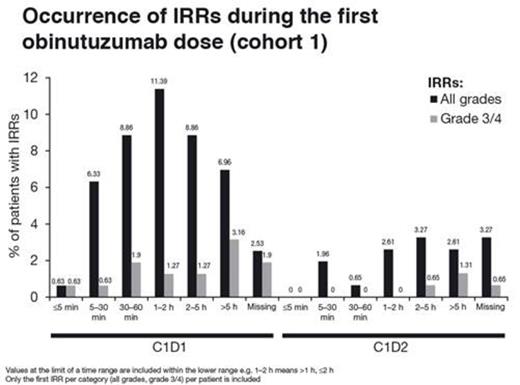Abstract
Background: The novel, glycoengineered type II anti-CD20 monoclonal antibody, obinutuzumab (GA101) has demonstrated superior efficacy to chlorambucil (Clb) monotherapy and to Clb in combination with rituximab (R-Clb) with an acceptable safety profile in CLL. However, an increased rate of infusion-related reactions (IRRs) has been observed with the obinutuzumab(G)-Clb combination compared with R-Clb during the first cycle of treatment. The GREEN study (NCT01905943) is an ongoing phase IIIb, multicenter, open-label trial investigating the safety and efficacy of obinutuzumab alone or in combination with chemotherapy in patients with previously untreated or relapsed/refractory CLL. We report safety data from cohort 1, which aimed to reduce IRRs on the first day of obinutuzumab administration in previously untreated patients using a lower dose and slower infusion rate than in previous studies.
Methods: Subjects aged ≥18 years withdocumented CLL, an Eastern Cooperative Oncology Group (ECOG) performance status of 0–2 and adequate hematologic function are enrolled. Treatment includes obinutuzumab (1000mg) administered intravenously on days (D) 1 (25mg) and 2 (975mg), D8, and D15 of cycle (C) 1, and on D1 of C2–6, alone (any patient: n=18) or in combination with 28-day cycles of chemotherapy: fludarabine plus cyclophosphamide (FC; n=46) for fit patients (cumulative illness rating scale [CIRS] ≤6 and creatinine clearance [CrCl] ≥70mL/min), Clb (n=8) for unfit patients (CIRS >6 and/or CrCl <70mL/min) or bendamustine (B; n=86) for fit/unfit patients. The primary outcome is safety, including the frequency, type and severity of adverse events (AEs). The present analysis focuses on IRRs, defined as treatment-related AEs occurring during or within 24 hours of infusion. Results were assessed to determine if a low obinutuzumab dose (25mg) and slow infusion rate (12.5mg/hour) on D1 (the current recommended C1D1 regimen is 100mg at 25mg/hour) could reduce IRRs. Analysis was based on a data cut-off of 28 April 2014, planned for when the first 150 previously untreated patients had completed cohort 1.
Results: Of 158 subjects eligible for the IRR analysis (Table), median age was 65.0 (34.0–83.0) years and the majority were males (65.2%) with Binet stage B (52.5%) or C (31.0%) CLL. Median observation time was 2.09 (0.2–6.0) months and median exposure time was 1.0 (0.0–4.8) month. IRRs occurring in ≥10% of patients were chills (14.6%) and pyrexia (15.2%). Serious IRRs in ≥1% of patients were tumor lysis syndrome (TLS; 3.8%) and pyrexia (1.3%). Grade ≥3 IRRs experienced by ≥1% of patients were TLS (5.7%), hypertension (1.3%) and hypotension (1.3%). IRRs were most frequent in C1D1 (Fig).
In the overall safety population (n=172; previously untreated patients) the most frequently reported serious AEs of special interest included IRR (8.1%) and neutropenia (11.0%). AEs of particular interest, thrombocytopenia, cardiac, and hemorrhagic events, were experienced by 16.3%, 3.5% and 3.5% of patients, respectively.
Conclusions: Preliminary safety data from the GREEN study, assessing the use of obinutuzumab alone or in combination with chemotherapy (B, FC or Clb) in subjects with untreated CLL, are in line with the known safety profile of obinutuzumab in similar populations. Although there is limited exposure time available for subjects in GREEN, IRRs seemed to be more manageable and a lower proportion of subjects with IRRs grade ≥3 was observed compared with previous studies. No new safety signals were reported. However, since the number of discontinuations during C1 was comparable with previous obinutuzumab studies, the decision was taken to further improve IRR rates by assessing additional dexamethasone premedication in cohort 2. Final safety data from the study will be presented at a later timepoint.
Bosch:Roche: Consultancy, Research Funding, Speakers Bureau. Off Label Use: GAZYVA (obinutuzumab) is a CD20-directed cytolytic antibody and is indicated, in combination with chlorambucil, for the treatment of patients with previously untreated chronic lymphocytic leukemia (CLL). This abstract reports on obinutuzumab alone or in combination with chemotherapy for previously untreated or relapsed/refractory CLL.. Lasserre:F. Hoffmann–La Roche: Employment. Truppel-Hartmann:F. Hoffmann–La Roche: Employment. Leblond:Roche: Honoraria, Membership on an entity's Board of Directors or advisory committees, Speakers Bureau. Foà:Roche-Genentech: Consultancy, Honoraria, Membership on an entity's Board of Directors or advisory committees, Speakers Bureau. Stilgenbauer:Roche: Consultancy, Honoraria, Research Funding.
Author notes
Asterisk with author names denotes non-ASH members.



This feature is available to Subscribers Only
Sign In or Create an Account Close Modal